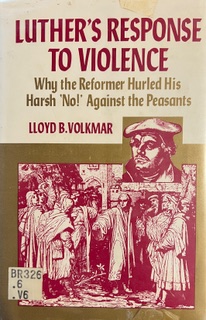A Brief Book Summary from Books At a Glance
by Bruce White
About the Author
Lloyd B. Volkmar had a Master of Theology degree from Brite Divinity School at Texas Christian University. At the time this book was published, he was serving as pastor at Lutheran Church of Our Savior in Fort Worth, Texas.
Table of Contents
Introduction
1 Luther’s World: His Development and Discovery
2 The Nature of His New Synthesis
3 The Plight of the Peasants and Their Rising Expectations
4 Confusion at Wittenberg and the New Challenge From the Left
5 The Peasant’s Revolt and Luther’s Response
Conclusion
Summary
Introduction
The author states in the introduction that the purpose of the book can be stated by asking why Luther wrote what he did against the peasants in 1525 when he himself came from peasant stock and was considered by the agrarian class as their champion who would deliver them from their wretched plight. It is important to study primary rather than secondary sources for this.
To understand Luther and his response to the peasants—a response in which he believed himself correct up to the day he died—one must begin by understanding the age and time (the sitz im Leben) in which he lived. This is done in chapter 1. “The nature of the new thought-synthesis which came to birth in the Reformation” (xxvii) is the subject of chapter 2. The third chapter covers the peasants’ situation, their grievances, and what they expected. What was happening in Wittenburg during Luther’s time in Wartburg sharpened Luther’s reaction as he dealt with the social doctrines of the Catholics on one hand and that of radicals on the other. Thus chapter 4. In the final chapter, we get to the ultimate question in the book, with the first four chapters providing the necessary background. This is followed by a short concluding chapter.
Chapter 1: Luther’s World: His Development and Discovery
Feudal life consisted of a hierarchy of three levels—clergy, nobles, and peasants. During the Dark Ages, the empire was partitioned into many small principalities, duchies, kingdoms, and city-states. Over the same time period, the church had become an all-inclusive institution. Religion was all-pervasive. Thomas Aquinas’ system of thought, merging Aristotle and Augustine, was the basis for subordinating temporal authority to the hierarchical Church.
Thomism was attacked by the Franciscan Duns Scotus and the nominalist William Occam. The Renaissance, with its “this-worldly” focus, almost offered a competing view of life from that of the Church. At the same time, the papacy was in a long period of decline and the popes themselves adopted the Renaissance spirit. Along with the decline, many abuses came into the church such as simony and concubinage.
As papal spending increased, new forms of revenue were created including new taxes and the system of indulgences. Efforts at reform came and went. Sectarian groups prepared peoples’ minds for a reformation via their sharp criticism of the established church. Europe was disunited by petty jealousies among the various estates and therefore could not mount a united front against the incursion of the Turkish empire. This last provided a background for Luther’s intense eschatological outlook.
Feudal society was transitioning into capitalism. Currency began to predominate. There was a rising middle class. Inflation created hardships for many segments of society which often led to violence. Throughout the 1400s peasant insurrections were a frequent occurrence. This was the world into which Luther was born.
Although Luther was born out of generations of peasants, his family was not poor. He grew up during the late years of the Renaissance and the growth of humanism, but these movements did not really leave a deep mark on him. Luther was especially influenced by nominalism. He broke off his studies at Erfurt as the result of his experience with the severe thunderstorm when he vowed to St. Anna that if she saved him, he would become a monk. On July 15, 1505, he entered an Augustinian monastery of the strict Observant kind.
His struggles to find God in the monastery were intensified as he performed all he was required to do. He desperately sought to find favor with God. John von Staupitz urged Luther to focus on the love of God and think of Christ and His shed blood. But Luther’s only view of Christ at the time was of an avenging Christ.
The dark night of the soul he experienced in the monastery changed his question from “What must I do to be saved?” to “What has God done to save me?” This new starting point was God and the revelation of his justifying grace. This change of focus is generally referred to as his “Tower Experience”.
From 1513-1517, his lectures on Psalms, Romans, and Galatians proved to be life changing for Luther. It was in Romans 1:17 that the righteousness of God gained an understanding in Luther’s mind. Luther felt that he had been born again when he realized the righteousness of God was the “passive righteousness with which the merciful God justifies us by faith” (56). Volkmar agrees with Wilhelm Pauck’s conclusion that Luther’s conversion should be dated in the 1514-1515 time period. . . .
[To continue reading this summary, please see below....]The remainder of this article is premium content. Become a member to continue reading.
Already have an account? Sign In
Buy the books

LUTHER’S RESPONSE TO VIOLENCE: WHY THE REFORMER HURLED HIS HARSH ‘NO!’ AGAINST THE PEASANTS, by Lloyd B. Volkmar